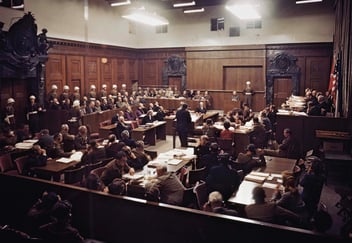It began not with the clamor of revolution but with the quiet hum of algorithms. The reshaping of humanity, the erosion of sovereignty, and the rise of technocracy unfolded without riots in the streets or banners in the squares. Instead, it crept into daily life through convenience, efficiency, and promises of progress. The silent revolution, as Ahmad framed it in the High Court of Malaya, was the most insidious threat humanity had ever faced. It did not need to shatter doors; it simply rewrote the locks.
Ahmad stood before the Court, a lone figure speaking against the tide of history. He spoke not of future hypotheticals but of a present reality—an engineered transformation that had infiltrated institutions, rewired culture, and molded society to fit the vision of global elites. This was not a war fought with weapons but a battle waged through ideas, systems, and silent compliance.
The Architecture of Control
At the heart of this silent revolution was the architecture of control—a framework so pervasive that it had become invisible to most. Ahmad described how the Fourth Industrial Revolution (4IR) had redefined human life, not as a series of relationships and experiences but as a network of data points. The Internet of Bodies (IoB), biometric currencies, and artificial intelligence had not merely supplemented humanity’s capabilities; they had begun to supplant its essence.
Ahmad presented evidence of systems that promised to make life easier yet quietly stripped away autonomy. Smart cities monitored every movement under the guise of safety. Biometric authentication ensured access but demanded submission. Even everyday interactions were mediated through platforms that recorded, analyzed, and monetized human behavior.
“Is this progress?” Ahmad asked, turning to the panel of judges. “Or is it the construction of a gilded cage, where freedom is reduced to the illusion of choice?”
The Unseen Hand
The silent revolution did not operate openly. It was orchestrated through a confluence of interests—governments, corporations, and technocratic elites—each playing a role in reshaping society. Ahmad detailed how policies like stakeholder capitalism, framed as inclusive and sustainable, concentrated power in the hands of the few while marginalizing the many.
He recounted the rise of Central Bank Digital Currencies (CBDCs), which tethered economic participation to compliance with state and corporate standards. He described the use of artificial intelligence to predict and influence human behavior, turning individuals into commodities to be analyzed, controlled, and exploited.
“Who benefits from this system?” Ahmad asked, his voice steady but piercing. “And who pays the price? This is not innovation; it is exploitation, masquerading as progress.”
The Role of Fear
Ahmad’s most striking argument was that the silent revolution thrived on fear. He traced its roots to crises—real and manufactured—that created fertile ground for radical transformation. The COVID-19 pandemic, climate emergencies, and economic instability were not merely challenges; they became tools to justify the erosion of freedoms.
He cited how emergency measures, once temporary, became permanent fixtures of governance. He described how fear of disease justified digital surveillance, how fear of financial collapse necessitated centralized control, and how fear of environmental catastrophe silenced dissent.
“Fear,” Ahmad declared, “is the most potent weapon of this revolution. It turns rational beings into compliant subjects, willing to trade their sovereignty for the promise of safety.”
The Erosion of Identity
Central to Ahmad’s argument was the erosion of identity in the name of progress. Transhumanism, a cornerstone of the Fourth Industrial Revolution, promised to enhance humanity but threatened to redefine it entirely. The integration of biosensors, genetic engineering, and artificial intelligence was not merely a technological leap; it was an existential shift.
Ahmad recounted stories of individuals reduced to data points, their identities fragmented across digital platforms. He spoke of communities reshaped by algorithms, where human relationships were replaced by transactional exchanges mediated by technology.
“This revolution does not seek to improve humanity,” Ahmad asserted. “It seeks to replace it.”
Resistance in Silence
Despite its reach, the silent revolution was not without resistance. Ahmad drew attention to those who questioned, who resisted quietly in their homes, workplaces, and communities. He highlighted movements reclaiming sovereignty over food, education, and local economies, rejecting the technocratic vision in favor of human-centered values.
Yet, Ahmad acknowledged the challenges faced by such resistance. The systems of control were designed to isolate dissenters, to render them invisible in the sea of compliance. But invisibility, he argued, could be a strength. “In silence,” he said, “there is power. Resistance does not always need to shout; sometimes, it is enough to refuse.”
A Call to Vigilance
As Ahmad concluded his argument, he issued a call to vigilance. The silent revolution thrived on apathy, on the willingness of individuals to accept what was given without question. To resist, he argued, required not only action but awareness—a willingness to see beyond the surface and question the narratives shaping society.
“This revolution does not wear the face of tyranny,” Ahmad said. “It wears the mask of progress. And that is why it is so dangerous.”
The Court adjourned for the day, but the weight of Ahmad’s words lingered. He had not merely exposed the mechanisms of the silent revolution; he had challenged those present to see it for what it was—a redefinition of humanity itself.
The chapters ahead will delve into the strategies of resistance, the philosophies underpinning the fight for justice, and the human stories driving this battle. But for now, the silent revolution stands revealed, its façade of progress stripped away to expose the machinery of control beneath. The question remains: Will humanity wake from its slumber before it is too late?




